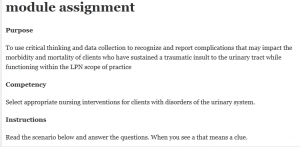module assignment

Purpose
To use critical thinking and data collection to recognize and report complications that may impact the morbidity and mortality of clients who have sustained a traumatic insult to the urinary tract while functioning within the LPN scope of practice
Competency
Select appropriate nursing interventions for clients with disorders of the urinary system.
Instructions
Read the scenario below and answer the questions. When you see a that means a clue.
The Story
It is Friday the 13th and a full moon. You are an LPN that normally works on a medical-surgical unit, but your unit is overstaffed, and the emergency department is short staffed. The nursing supervisor asks for a volunteer to go down to be an extra pair of hands. You volunteer as tribute. When you get to the ER, you are asked to do vitals on a client in the trauma room. The client is a 24-year-old male who was stabbed multiple times to the abdomen.
The wounds appear superficial, and the client has been stable thus far. He will be going to CAT scan as soon as they can fit him in. You approach the client, who appears slightly pale with cool, clammy but is alert and talkative. The vital signs are:
97.3 (PO) P= 115 BP= 95/54 Resp rate= 24 Pain= 6/10. You notice the client voided 100 mL tea-colored urine in his urinal.
One hour later, the client becomes unconscious. His pulse is now 144, and blood pressure is 70/50. The client is taken to the OR and has a nephrectomy for a very damaged and bleeding right kidney.
Answer the following questions:
1. What were the clues in the data collection that should have alerted you and the staff that there might be a problem? (5-10 sentences)
2. Why is the urine “tea-colored?” (one sentence)
3. What are some other interventions that could have been done? (2-5 sentences)
4. Was the LPN in this scenario working within the scope of practice for an LPN? Why or why not? (5-10 sentences)
5. How did the environment of care (busy ER) contribute to the client’s deterioration? (5-10 sentences)
Format
. Standard American English (correct grammar, punctuation, etc.)
. Logical, original and insightful
. Professional organization, style, and mechanics in APA format
. Submit document through Grammarly to correct errors before submission
Module 03 Content
APA format
Top of Form
Purpose
To identify maladaptive breathing patterns and intervene as necessary
Competency
Explain care for the client with upper respiratory disorders.
Instructions
Read the scenarios and answer the questions that follow each. Please cite any sources using APA format.
Scenario # 1
A 45-year-old male comes to the ER unconscious. A co-worker went to check on him when he did not show up for work and found him unconscious. The client is a type one diabetic. His respirations are 36, and his breath has a “fruity” scent. His respirations are both deep and rapid. Labs are drawn, and his glucose is 1024.
· Why does this client have rapid, deep respirations and “fruity” smelling breath? (5-10 sentences)
Scenario # 2
A 94-year-old in long-term-care is terminally ill and has been placed on hospice care. Her family summons you because her breathing has become erratic. You observe periods of rapid, deep respirations followed by periods of apnea.
· What should the nurse do next? (5-10 sentences)
Scenario # 3
A 64-year-old male comes via car to the clinic where you are working. His wife reports he has been having “trouble breathing” for the past several days, but today it is much worse. The client is unable to speak and appears very anxious. His respiratory rate is 48.
· What is the priority nursing intervention? (5-10 sentences)